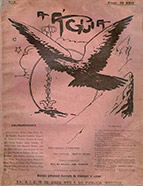

................................
During the magazine’s most prolific phase, between 1912 and 1916, many authors — such as Jaime Cortesão, Sampaio Bruno, Damião Peres, Raul Proença, João Ameal, Hernâni Cidade, Delfim Santos, and Agostinho da Silva — contributed writings of historiographical interest, although some were only reviews or obituaries. Notably, a variety of documents reflected a shared quest for a heroic past and a rediscovery of collective glory. In the January 1912 issue, António Sérgio, in his piece A ideação de Oliveira Martins [The Ideation of Oliveira Martins], celebrated the creative and imaginative qualities of Martins, an author Sérgio knew well and described as a "historian-romanticist." Teófilo Braga’s writings appeared in various forms, such as in Na cela de San Yuste [In the cell of San Yuste] (Issue 5, May 1912), a short fictional narrative about Charles V reflecting on his past greatness from the solitude of a convent. Other notable pieces include Renascença. Século XVI [Renaissance. Sixteenth Century] (Issue 14, January 1913) and A Revolução de 1640 [The Revolution of 1640] (Issue 41, May 1915). The essay As grandes épocas sociais têm por síntese uma epopeia [The Great Social Epochs are Synthesised by an Epic], written in August 1914 by Teófilo Braga, revives an idea dear to the Portuguese Renaissance and present in the earlier works of Cortesão: the notion that there are moments in history when collective action unites around a common aspiration or an ideal that transcends personal interests and conflicts, giving rise to a collective soul whose fullest expression is the epic. Braga’s perspective shares an intellectual affinity with Pascoaes, who references añoranza — the Galician equivalent of nostalgia or melancholy. Meanwhile, the Catalan Lusitanist Ribera i Rovira, who corresponded with A Águia between 1912 and 1919, published two talks: A Educação dos povos peninsulares [The Education of the Peninsular Peoples] (1912) and O Génio peninsular [The Peninsular Genius] (1914), which were issued by the Portuguese Renaissance. In A Educação dos povos peninsulares , published in the magazine in May 1912, Rovira advocated for uniting the three distinct homelands that he identified on the Iberian Peninsula — Castile, Catalonia, and Portugal — following the Iberianist tradition of Catalonia. His arguments for a future Iberian federation, underpinned by a shared cultural heritage and the notion of a "peninsular genius," were compelling. In Rovira’s writings for A Águia, the influence of Oliveira Martins, who profoundly shaped Portuguese and Spanish Iberian cultural thought, is apparent. Rovira quoted Martins and praised him as a "high Iberian spirit [who] admirably defined the Castilian soul" (“A Catalunha”, Idem , Issue 21, September 1913). Another text aligning with the historiographical outlook of A Águia is Os Descobrimentos dos Portugueses e a viagem de Magalhães [The Portuguese Discoveries and the Voyage of Magellan] by writer and diplomat Alberto de Oliveira.
This work is financed by national funds through FCT - Foundation for Science and Technology, I.P, in the scope of the projects UIDB/04311/2020 and UIDP/04311/2020.
